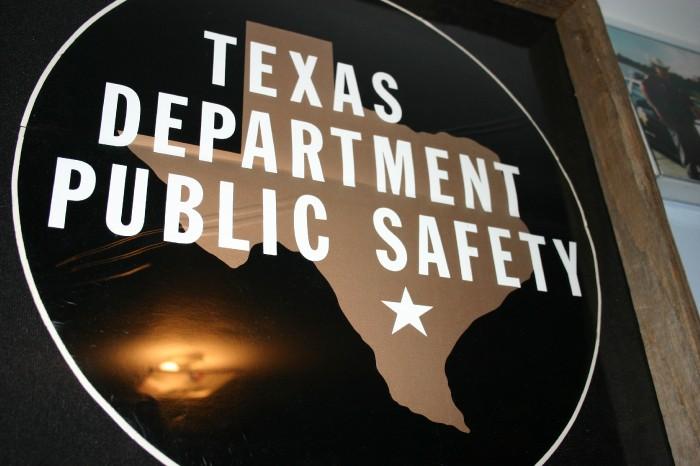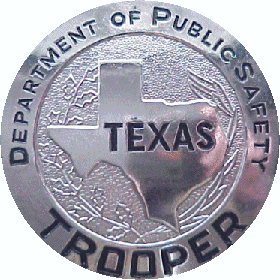


 |
 |
 |
|---|---|---|
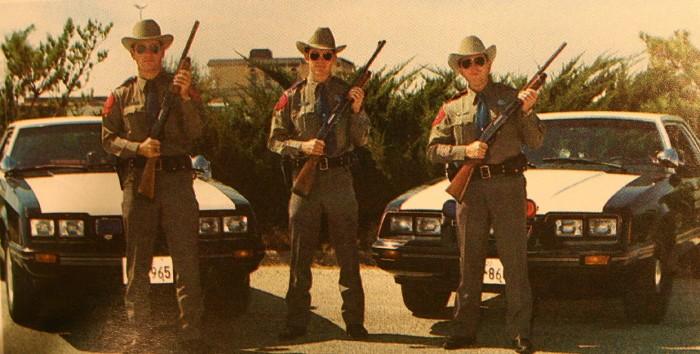 |
The Texas Department of Public Safety (Texas Highway Patrol) started using the Special Service Mustang in 1983, when they ordered 24 (reportedly 24, may be as high as 26) units for patrol use. That began a run with Texas DPS through the 1993 model year, with Texas purchasing Mustangs every year except for 1991 and 1992. Texas purchased upwards of 500 of the cars, making them probably the third largest agency-user of the SSP Mustang. There are many of these cars left in existence, and many enthusiasts who wish to restore them, as accurately as possible, back to in-service condition. With this in mind, we have compiled the following as a reference to use for restoration, with as much detail and fact-based documentation as possible included.
|
Ordering History
1983 was the first year that Texas ordered Mustangs, after testing a 1982 model. They ordered their units with the radio noise suppression option, "aircraft" hose clamps, decklid relocated to the left hand lower dash, and cruise control (a rare option for an early SSP). The cars were based on the “GL” trim line, with cloth and vinyl-trimmed bucket seats in Black. DPS ordered cruise with their vehicles, with an exception in 1987, throughout the Mustang run.
For 1987, DPS mixed things up a bit with their order, as well as the outfitting of the 1987 fleet. 100 or so of the cars were ordered with automatic transmissions, as DPS reportedly wanted to test the durability of AOD-equipped cars. Most, if not all, of the previous cars were 5 speeds. The 1987 fleet did not come equipped with cruise control, unlike the previous cars. Also, the 1987 cars did not have the engine oil coolers (1986 did, as did the cars purchased after 1987). The '87 cars did have the silicon hose package, as well as single-key locking (a first for DPS).
1990 saw the first year of a new interior color, which was Titanium (code “A”, replacing Smoke Gray ). Texas did not order any Mustangs for 1991 or 1992.
1993 was the last year for the SSP Mustang, and Texas' last order for the cars was in a mixture of Black and the new-for-'93 Opal (Grey) and Red (Ruby Red) interiors. The 1993 cars were also run without spotlights.
Emergency Lighting & Equipment Most DPS Mustangs through 1989 were slicktop cars, with a few exceptions. For 1983-1984, DPS ran round, halogen flashers (PAR 36-type, alternating red and blue) up front, with a red dashlight (in-service photos show Whelen Responder models). The front lights were mounted with in-house fabricated brackets, and the 1983 cars had them mounted at least two different ways; high, with the tops of the lights protruding up
over the top of the hood, and low, with the lights almost touching the top of the front bumper. For 1984 and beyond, the latter mounting seemed to be the standard installation. '83-'84 cars used the same round red and blue halogens for rear decklights. The siren speaker was located behind the front bumper.
1985 DPS Mustang, with SHO ME-style front halogen lights. This
is a good shot of the front brackets for the lights, which were fabricated in-house. Image courtesy of Roman Collins.
Starting in 1987, DPS migrated to more effective Whelen strobes up front. Whelen Micro-Grill Masters, with aluminum housings, were the lights originally used, and these were run with a 2-position, separate power supply. The bulbs and reflectors for these lights are the same, internally, as the popular Whelen Dashmasters (which are self-contained and do not require a power supply). Rear deck lighting remained halogen, though. Later slick-top cars also ran front strobes made by Tomar. DPS did start using lightbars on some '87-'88 cars (as well as sporadic usage on a few earlier cars), but more widespread use of the bars began in 1989. These lightbars were the LP 6000/Force 4 LP made by Code 3. DPS didn't order any Mustangs in 1991 or 1992, and the 1993 Mustangs ran Federal Signal Jetsonic lightbars with Code 3 Traffic Advisors behind them (they no longer ran slicktops). Wig-wag headlight flashers were also sporadically used prior to 1989, but became more widespread in the later cars. Models used varied, and close inspection of the headlight harness will help determine if a particular car was equipped with them.
Markings
Drivers door seal, early style. Tony Scharp photo.
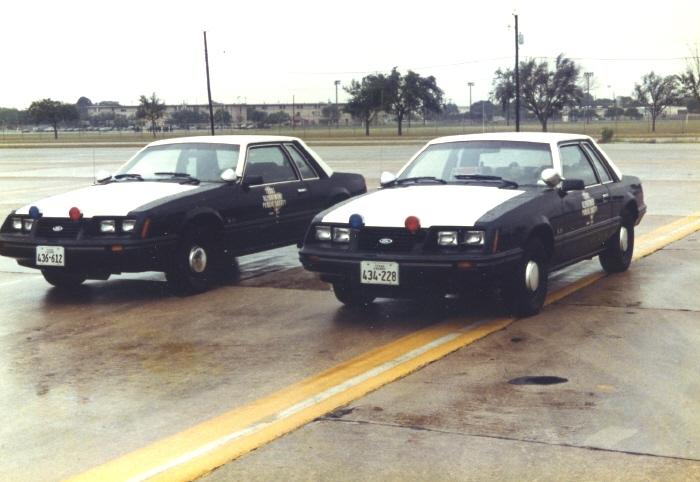
1983 Mustangs with the front, PAR halogens mounted up high. Image courtesy of Roman Collins.

Here is a shot with the lights mounted lower, and the Whelen Responder on the dash. This car is the same one pictured
above, license 434-228, showing the lights were moved at some point. Image courtesy of Roman Collins. 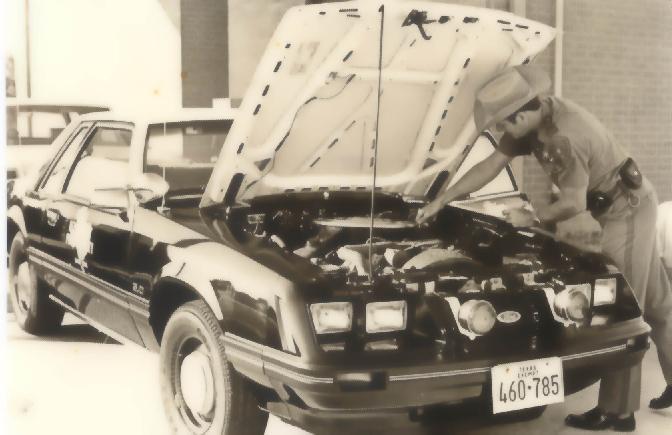
Here is an 1984, with a slightly different front mount. Image courtesy of Tony Scharp.

Rear of an 1984, showing the same round halogens on the rear deck. Image courtesy of Tony Scharp.
For 1985-1986, DPS ran rectangular halogen lights, still red and blue, both up front and on the rear package tray. SHO-ME still makes an identical light, with the correct chrome housing. Inside, dash lights such as the Whelen Responder were still seen, as well as teardrop-type rotating lights (SVP or Federal Fireball II style, with red lenses) and red dash strobes (early Whelen FB2).


Another shot, 1985. Image courtesy of Roman Collins.
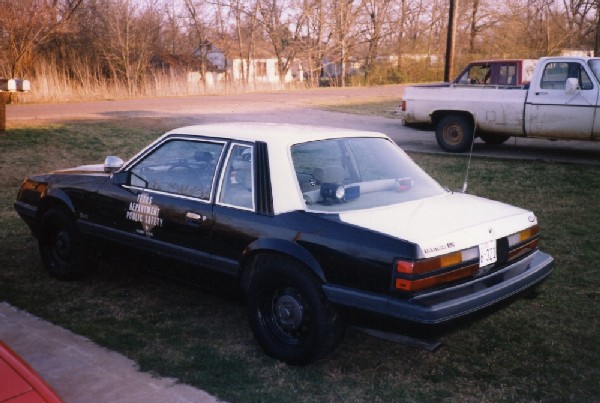
Rear shot of an '85, with the rear halogen lights and a Decatur, rear radar antenna on the rear deck. Image courtesy of Roman Collins.
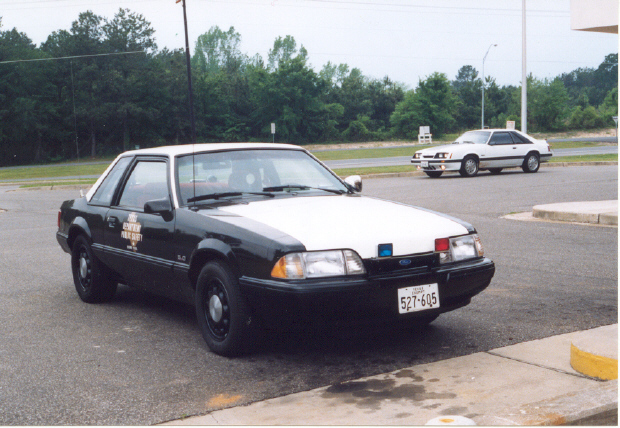
'87 DPS slick-top. The '87's are easy to spot because they didn't run dual spotlights that year. Image courtesy of Roman Collins.

Another '87, this one is rare...equipped with a Code 3 lightbar.Image courtesy of Roman Collins.
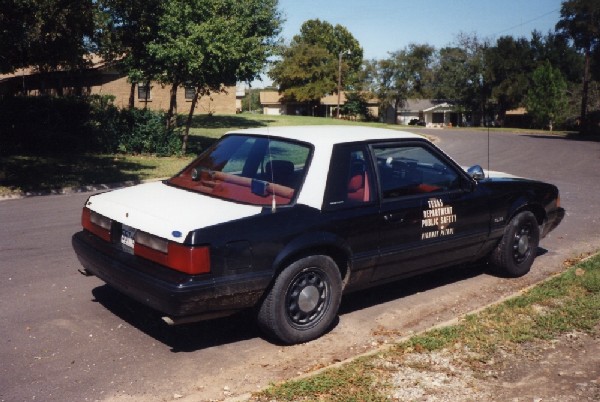
'88-'89 DPS, rear shot. Halogens on the package tray, decibel products antenna on the rear quarter. Image courtesy of Roman Collins.

1993 DPS Mustang with Jetsonic/TA combo. Image courtesy of Roman Collins.

Another shot of the 1993. Image courtesy of Roman Collins.

1993 with a nice shot of the interior electronics and rear Code 3 arrowstick. Image courtesy of Tom Mallette.
Early DPS Mustangs may not have used switchboxes to control the lights, but later cars (1988-up) did. The unrestored 1983 DPS car (pic will be added below) still has an original mic clip, with holes cut into the console delete surround for switches. DPS used several different varieties of switchboxes, including those made by Federal Signal and Code 3. These were made especially for DPS, and usually had "Texas Department of Public Safety" printed on the front of the boxes.
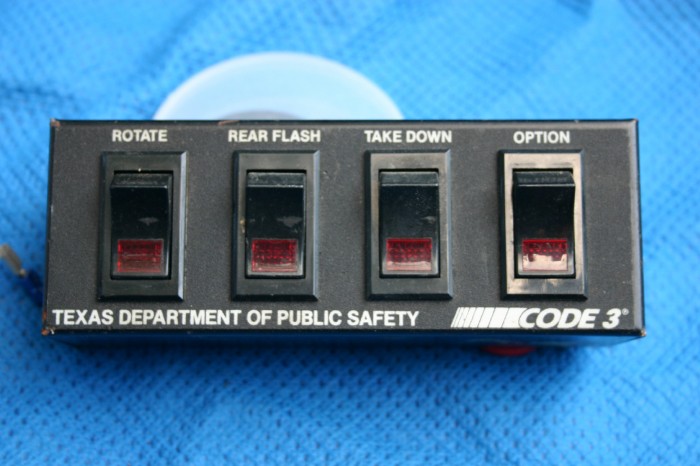
1988-1990 Code 3 switchbox. Image courtesy of Tony Scharp.

1993 Federal Signal switchbox. Image courtesy of Tony Scharp.
1983-1986 Mustangs used separate sirens, but the 1987-up cars receiving the Syntor XX radios utilized an integrated, Motorola siren amplifier used in conjunction with the radio (and mounted in the trunk with the radio tray). The Federal PA200 siren would be correct for an early car.
DPS's door seals are about 13 inches in diameter, and the correct Mustang seals were screen-printed on non-reflective adhesive. The "Highway Patrol" lettering was originally placed just above the door belt molding on the early (1983-1986) cars, but was later moved up to the top of the door. 1993 was the only year for the fender and trunk lettering (white for the fenders, black for the trunk).
